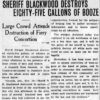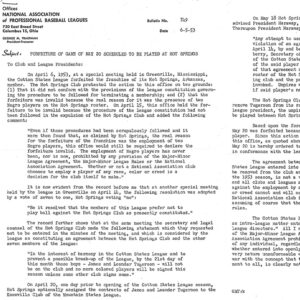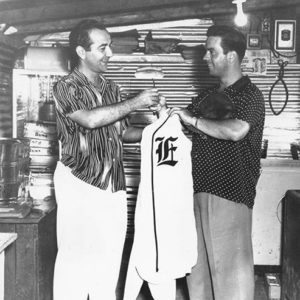calsfoundation@cals.org
Cotton States League
The Cotton States League was founded at Vicksburg, Mississippi, in 1902 and comprised teams from Louisiana, Mississippi, and Arkansas; there were occasional entries from Texas, Alabama, and Florida. In Arkansas, teams were established in Pine Bluff (Jefferson County), El Dorado (Union County), Helena (Phillips County), and Hot Springs (Garland County). The National Association of Professional Baseball Leagues (NAPBL), the administrative agency of minor league baseball from 1901 to the present, sanctioned the league.
The league operated as a Class D league, typically the lowest level of professional competition, from 1902 to 1932, though it played no games in 1909 and suspended operations from the fall of 1913 to 1922. From 1936 to 1955 (with the exception of 1942–1946 when it suspended operations due to World War II), the league operated as a Class C league. While it existed, the league built a rich history, sending scores of players to the major leagues and offering a consistently high caliber of play. Former major league veterans from the Cotton States League include Walton Cruise, Frank O’Rourke, Jonas “Jittery Joe” Berry, Mickey Harris, Odell “Bad News” Hale, and Mount Ida’s (Montgomery County) Lon Warneke, known as the “Arkansas Hummingbird.” However, the league’s defining moment came during an effort to integrate the league in 1953.
The fortunes of the Cotton States League often reflected the state of the region’s economy, unique challenges, and even international events. In 1905, the league shut down in July during the yellow fever epidemic. In order to survive during the Great Depression, the league merged with the East Texas League and the Texas Association, forming the Class C Dixie League in 1933 and the Class C East and West Dixie Leagues in 1934–1935. In 1936, the Class C Cotton States League returned until 1941.
After the war, from 1947 to 1951, minor league baseball enjoyed a boom in business. For instance, in 1949, the Pine Bluff Cardinals welcomed 83,425 fans through the turnstiles, while at the league’s all-star game at Helena that same year, 2,165 fans packed the ballpark. Overall, the Cotton States League witnessed a robust return to the field, entertaining nearly 2 million fans over those five seasons. The boom was short lived, however.
By 1952, major league baseball games were widely broadcast on radio and television, and new recreational options were emerging across America. Minor league baseball found itself in fierce competition for the public’s entertainment dollar. This evolving economic paradigm hit the Cotton States League hard. Meanwhile, in tandem with professional baseball’s resurgence in 1947, Jackie Robinson broke the color barrier in major league baseball. Conversely, the Cotton States League steadfastly resisted integrating. In the process, the league alienated an untold number of potential African-American fans.
Thus, the 1953 season looked bleak for some teams—the Hot Springs Bathers in particular. In an effort to improve their prospects on the field and at the gate, the Bathers signed two highly touted pitchers from Florida, Jim Tugerson and his younger brother, Leander. Both possessed fine professional baseball resumes and were African American.
Initially, Arkansas clubs at Pine Bluff and El Dorado professed no qualms about the Bathers’ intention to integrate the league, nor did the franchise in Monroe, Louisiana. In Mississippi, however, calls to oust the Bathers from the league grew intense among the league’s directors. The Bathers offered to use the Tugerson brothers only in games in Arkansas and Louisiana, an offer that was rejected. On April 6, the league voted to expel the Bathers. League president Al Haraway of Helena characterized the Bathers’ actions as an act of “treason.” Mississippi’s attorney general, J. P. Coleman, insisted that racially integrated competition violated the state public policy, basing his edict upon his interpretation of the Mississippi constitution, which emphasized segregation. On April 15, however, the NAPBL ruled against the league, reinstating the Bathers.
The Tugersons’ right to play was generally supported in Arkansas newspapers. But “in the interest of harmony,” the Bathers sent the Tugerson brothers to a Class D club in Knoxville, Tennessee, with which the Bathers had established a working agreement. In addition, the Bathers promised not to recall the Tugersons. However, by May 18, suffering on the field and at the gate, the Bathers recalled Jim Tugerson to pitch in Hot Springs on May 20. Haraway issued a telegram stating, “Umpires will be instructed to forfeit game immediately if said player’s name appears on batting order.” Tugerson’s name appeared, as did a capacity crowd of 1,500 fans. The game was forfeited.
On June 5, NAPBL president-treasurer George M. Trautman declared the forfeiture invalid and ordered the game to be rescheduled. Trautman’s support came too late for Tugerson, as he was returned to Knoxville. At Knoxville, Tugerson went on to win twenty-nine games, and he led his team to a league championship. Tugerson unsuccessfully sued the Cotton States League in federal court for violating his constitutional rights, as well as for breach of contract. The civil rights portion of his suit was dismissed because his claim was against a private concern, not a government entity; the judge never ruled on the other portion of his suit.
In 1954, the Bathers integrated the league when they signed outfielder Uvoyd Reynolds, out of Langston High School in Hot Springs on July 20. Although it sparked interest in the Bathers, signing the light-hitting Reynolds in 1954 was too little too late. The opportunity to capture the imagination of their fans and to take a bold stand against Jim Crow eluded the Bathers and the rest of the league. In the end, the anticipation that the Bathers generated with the Tugerson signings was lost, and the episode was a bitter disappointment for the league’s black fans. The league folded in 1955.
| Teams |
Years of Operation
|
Championship Seasons
|
|
Alexandria (LA) |
1925–1930 |
|
|
Baton Rouge (LA) |
1902–1906, 1929–1932 |
1903, 1932, 1933 |
|
Brookhaven (MS) |
1924–1925 |
|
|
Clarksdale (MS) |
1913, 1922–1923, 1936–1941, 1947–1951 |
|
|
Cleveland (MS) |
1936 |
|
|
Columbus (MS) |
1907–1908, 1912–1913 |
|
|
DeQuincy (LA) |
1932 |
|
|
El Dorado (AR) |
1929–1932, 1936–1941, 1947–1955 |
1929*, 1930, 1936, 1937, 1954 |
|
Greenville (MS) |
1902–1905, 1922–1923, 1936–1941, 1947–1951 |
1905, 1923, 1939 |
|
Greenwood (MS) |
1910–1912, 1922–1923, 1936–1949, 1947–1952 |
1910, 1912, 1922*, 1947 |
|
Gulfport (MS) |
1906–1907, 1926–1928 |
|
|
Gulfport-Biloxi (MS) |
1908 |
|
|
Hattiesburg (MS) |
1905, 1910–1912, 1923–1929 |
1924, 1926*, 1928 |
|
Helena (AR) |
1936–1941, 1947–1949 |
|
|
Hot Springs (AR) |
1938–1941, 1947–1955 |
1941, 1948, 1950 |
|
Jackson (MS) |
1905–1908, 1910–1913, 1922–1932, 1936, 1953 |
1908, 1913, 1927*, 1929, 1931* |
|
Lake Charles (LA) |
1929–1930 |
|
|
Laurel (MS) |
1923–1929 |
|
|
Marshall (TX) |
1941 |
|
|
Meridian (MS) |
1905–1908, 1910–1913, 1922–1923, 1925–1929, 1952–1955 |
1922*, 1925*, 1952, 1953 |
|
Mobile (AL) |
1905–1907 |
1906, 1907 |
|
Monroe (LA) |
1903–1904, 1908, 1924–1932, 1937–1941, 1950–1955 |
1927, 1938, 1940, 1955 |
|
Natchez (MS) |
1902–1905, 1948–1953 |
1902, 1949, 1951 |
|
New Orleans (LA) |
1912 |
|
|
Opelousas (LA) |
1932 |
|
|
Pensacola (FL) |
1913 |
|
|
Pine Bluff (AR) |
1903–1905, 1930–1932, 1936–1940, 1948–1955 |
1904, 1930* |
|
Port Arthur (TX) |
1932 |
|
|
Selma (AL) |
1913 |
|
|
Texarkana (TX) |
1941 |
|
|
Vicksburg (MS) |
1902–1908, 1910–1912, 1922–1931, 1937, 1941, 1955 |
1911, 1928*, 1931* |
|
Yazoo City (MS) |
1910–1912 |
|
*Co-champions; prior to holding playoff series, the league awarded first and second half titles.
For additional information:
“2 Negro Stars Optioned.” New York Times. April 21, 1953, p. 34.
Adelson, Bruce. Brushing Back Jim Crow: The Integration of Minor-League Baseball in the American South. Charlottesville: University of Virginia Press, 1999.
“Cotton League Sued.” New York Times. July 14, 1953, p. 21.
Duren, Don. Bathers Baseball: A History of Minor League Baseball at the Arkansas Spa. Maitland, FL: Xulon Press, 2011.
“Five Deaths: Day’s Toll to Yellow Fever Scourge.” New York Times. August 1, 1905, p. 4.
Friend, J. P. Cotton States League Golden Anniversary, 1902–1951. Helena, AR: National Association of Professional Baseball Leagues, 1951.
“Hot Springs Plans to Recall Negroes.” New York Times. June 7, 1953, p. 3S.
“Hot Springs Reinstated.” New York Times. April 15, 1953, p. 42.
“Jackson Wins On Forfeit.” New York Times. May 21, 1953, p. 41.
Johnson, Lloyd, and Miles Wolff, eds. Encyclopedia of Minor League Baseball. 3rd ed. Durham, NC: Baseball America, 2007.
“League Throws out Club with 2 Negro Pitchers.” New York Times. April 7, 1953, p. 36.
Morris, Peter. “Jim Tugerson.” The Baseball Biography Project. http://bioproj.sabr.org/bioproj.cfm?a=v&v=l&bid=1643&pid=19546 (accessed March 7, 2022).
“Negro Pitcher Optioned after Game Is Forfeited.” New York Times. May 22, 1953, p. 21.
“Negro Players Barred.” New York Times. April 2, 1953, p. 36.
Voigt, David Quentin. Baseball: An Illustrated History. University Park: Pennsylvania State University Press, 1987.
Paul Edwards
Boston, Massachusetts
 Blackwood, Dwight Hale
Blackwood, Dwight Hale Recreation and Sports
Recreation and Sports Cotton States League Memo
Cotton States League Memo  Hot Springs Bathers
Hot Springs Bathers  Oilers Owner Harry Brandt and Catcher Johnny Palazzini
Oilers Owner Harry Brandt and Catcher Johnny Palazzini 




My grandfather was the owner of the El Dorado Oilers from 1947 to 1950. I have some of the uniforms of the team and the Cotton States League baseballs that they used. My dad used to travel with the team as a kid and he’s got photos and mementos from that team. Sadly, not nearly enough has been written about that league.